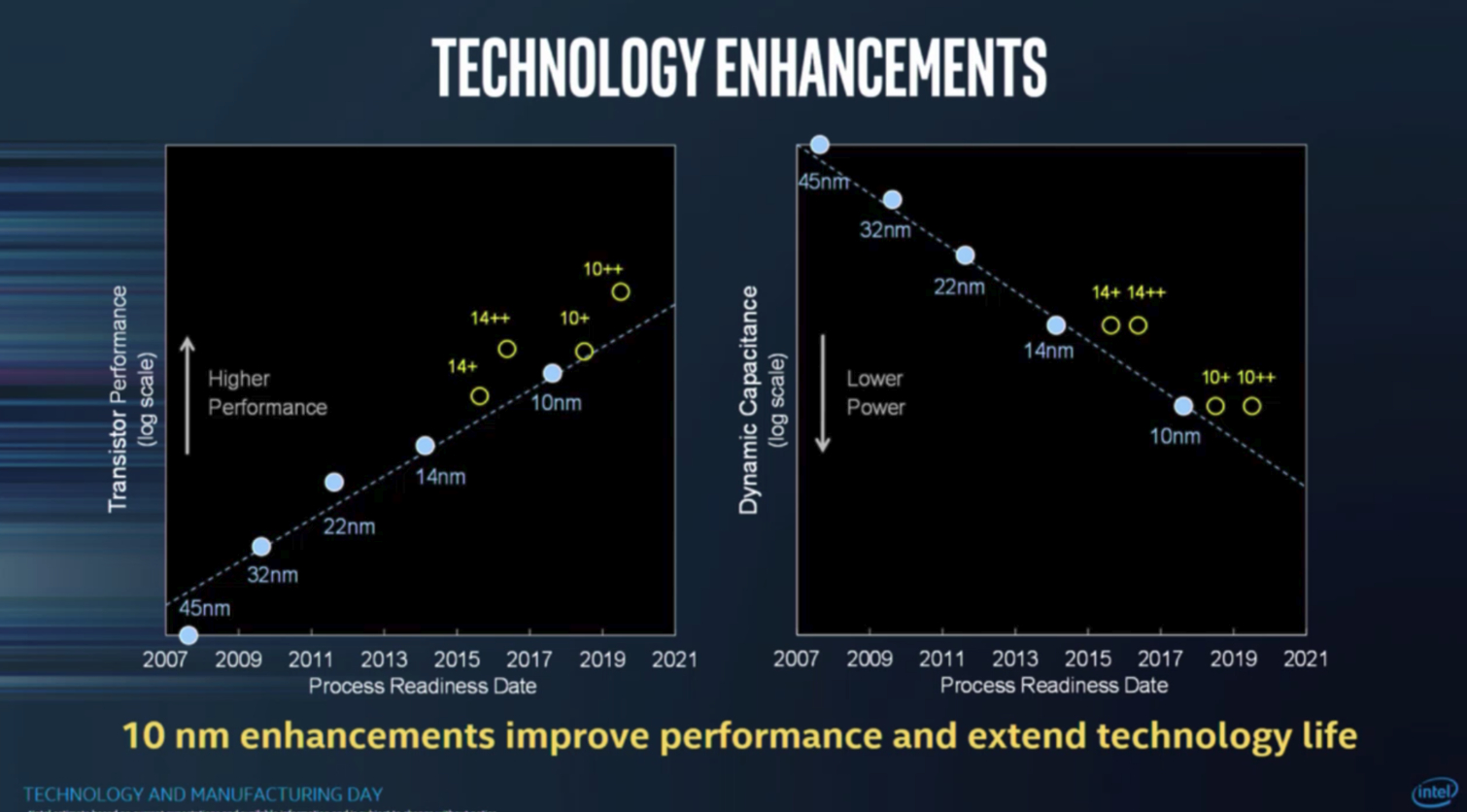Intel's First 10nm Processor Lands In China
Intel's much-anticipated, and oft-delayed, 10nm processors have popped up in a Lenovo Ideapad 330, which is a low-end notebook that comes with 4GB of memory and a 500GB HDD, at Chinese retailer JD.com.
The dual-core Core i3-8121U sports the Cannon Lake architecture, but the integrated graphics are either disabled or not present. As a result, the notebook comes with RX540 graphics. We followed up with Intel, which confirmed that the chips are only on sale in China. The company won't share a specific date for possible U.S. distribution, but it shared the full specs of the new processor.
Intel has long been known for its aggressive cadence of transitions to smaller process nodes, but the 10nm process has proven to be its biggest challenge in recent history. Intel first planned on delivering processors based on the smaller process in 2015, but now it has pushed high volume manufacturing back to 2019 due to yield issues that make the end products too expensive for mass production.
| Row 0 - Cell 0 | Intel Core i3-8121U | Intel Core i3-8130U |
| Architecture | Cannon Lake | Kaby Lake |
| Lithography | 10nm | 14nm+ |
| Cores/Threads | 2 / 4 | 2 / 4 |
| Base/Boost Frequency (GHz) | 2.2 / 3.2 | 2.2 / 3.4 |
| Cache | 4MB | 4MB |
| TDP | 15W | 15W |
| Memory Support | DDR4-2400, LPDDR4/x-2400 | DDR4-2400, LPDDR3-2133 |
| Memory Channels | 2 | 2 |
| Memory Bandwidth | 41.6 GB/s | 34.1GB/s |
| PCIe | PCIe 3.0 x16 | PCIe 3.0 x12 |
| Tjunction | 105C | 100C |
| Package Size | 45mm x 24mm | 42mm x 24mm |
| Integrated Graphics | No | Intel UHD Graphics 620 |
| AVX | AVX2 | AVX2 |
In the interim, Intel has released the Core i3-8121U to market. This new chip comes bearing the Cannon Lake microarchitecture, but the details of the new design are still wrapped in secrecy. We expect that the new architecture will provide improved instructions per clock (IPC) that will boost overall performance, but we won't know the details until the processors land in the hands of a capable tester. Intel isn't disclosing pricing on its newest chip, and it has yet to make an appearance on its processor pricing list.
The Core i3-8121U comes equipped with Turbo Boost 2.0, much like its closest cousin, the Kaby Lake Core i3-8130U. Both chips feature the same 15W TDP, but the Cannon Lake model comes with a 200 MHz lower Turbo Boost frequency, which could be offset by increased IPC. Last year, Intel revealed that its inaugural 10nm process would not provide more transistor-level performance than the highly-refined 14nm++ process, but the company does claim it will offer more performance than the 14nm+ used on the Kaby Lake models. We'll have to wait to see how that translates to chip-level performance.
The Core i3-8121U has a few new notable additions, such as 16 lanes of PCIe 3.0, which is an improvement over the Kaby Lake model's 12 lanes. Intel also included support for up to 32GB of LPDDR4, which yields higher memory bandwidth than the Kaby Lake model.
Intel increased the size of the package to 45 x 24mm, which means the chip isn't pin-compatible with the Kaby Lake BGA mounting. We also see a slightly increased Tjunction of 105C, which is the maximum temperature the chip can sustain before it begins throttling.
Get Tom's Hardware's best news and in-depth reviews, straight to your inbox.
It has long been rumored that the leading 10nm Intel chips come with a disabled graphics unit, but we can't be sure that Intel built the capability into the die. In either case, the -8121U comes without integrated graphics, which means it also doesn't support other graphics-acceleration features. Intel recently updated its Architecture Instruction Set Extensions And Future Features (PDF) document, which states that the Cannon Lake processors support AVX-512. The Core i3-8121U doesn't support the feature, but we wouldn't expect to find AVX-512 in low-cost notebooks anyway.
Intel's eighth-generation chips now include Kaby Lake, Coffee Lake, and Cannon Lake processors built on the 14nm+, 14nm++, and 10nm processes. The extended eighth-generation branding is indicative of Intel's continuing struggle to field new microarchitectures as it tries to deploy new process technologies. Intel has made impressive performance gains over the course of the four iterations of the 14nm process by tightening design metrics, but the company has curiously decided to lock its new microarchitectures behind the smaller process nodes. It's puzzling that Intel hasn't simply brought a new microarchitecture to the existing process, thereby offering larger performance benefits than we see with the rewarmed Skylake architecture.
For now, it seems that the Core i3-8121U will serve as a learning vehicle for Intel as it improves its 10nm process. The relatively unimpressive dual-core chip is also rumored to surface in the upcoming Crimson Canyon NUC next month.

Paul Alcorn is the Editor-in-Chief for Tom's Hardware US. He also writes news and reviews on CPUs, storage, and enterprise hardware.
-
husker ...because what better place to introduce the world to your cutting edge processor than a cheap laptop only available in China.Reply -
barryv88 It's 2018, and Intel brings out dual cores.... dual cores. No. Just no.Reply
Basically, this will allow AMD to give them a royal spanking, once their 7nm products roll out. And rightfully deserved. This is what you get when you steer anti innovation, anti competition, anti consumer, anti open source. What goes around, comes around. -
DerekA_C oh hey did you see these new chips only officially support 2400mhz memory and amds ryzen first gen supports 2667mhz and refined edition is 2933 and who knows with zen 2 at the end of the year AMD is coming back with a vengeance.Reply -
Martell1977 Reply20972387 said:...because what better place to introduce the world to your cutting edge processor than a cheap laptop only available in China.
I'm thinking it's more of a "beta" test. China isn't really used to quality, so a potentially buggy, low end, dual core would just be more accepted, especially in low volumes.
In most other countries, especially the USA, a low volume dual core would get panned and do more damage to Intel's image than it would be worth.
I'm thinking they are hemorrhaging money on this 10nm and we will see many generations on it. Even in low volume, it might bring a little of that money back. -
stdragon Reply20972420 said:It's 2018, and Intel brings out dual cores.... dual cores. No. Just no.
Basically, this will allow AMD to give them a royal spanking, once their 7nm products roll out. And rightfully deserved. This is what you get when you steer anti innovation, anti competition, anti consumer, anti open source. What goes around, comes around.
Yeah, I'm thinking Intel's yeild isn't doing so good. The best they can bin these chips at is probably either crippled to dual core (other cores disabled due to flaws), or as a simple production run to at least get some ROI on their fab investment in the interim. Either way, I have to agree, AMD is going to spank the crap out of Intel for the next year or so!
You know, honestly, Intel brought all this on themselves. Besides, competition is healthy, even if I'm not an AMD fan. So be it, I hope AMD does well this time around; they deserve it. -
bit_user Folks would do well to remember the 14 nm/Broadwell debacle. Basically, it was initially limited to smaller, lower clock speed chips, and so late that the desktop Broadwell SKUs got cancelled since Skylake was almost ready to ship right behind it.Reply
I think we're seeing a much worse version of that, with 10 nm. It's good that they were able to wring so much more out of 14 nm, or Intel would be in real trouble.
BTW, it's common to start with smaller chips on a new node, until the yields improve. That's why Intel has been starting new nodes on mobile, then desktop, and finally the huge server chips. -
sejiltv This just beyond pathetic! AMD Ryzen Mobile offers 8C/8T with Vega 10 graphics for a TDP of 15W. And here we have Intel with a 2C/4T without IGP for 15W. While TDP is not the best marker for power efficiency, still........ How the might have fallen.Reply -
utroz Reply20972610 said:Folks would do well to remember the 14 nm/Broadwell debacle. Basically, it was initially limited to smaller, lower clock speed chips, and so late that the desktop Broadwell SKUs got cancelled since Skylake was almost ready to ship right behind it.
I think we're seeing a much worse version of that, with 10 nm. It's good that they were able to wring so much more out of 14 nm, or Intel would be in real trouble.
BTW, it's common to start with smaller chips on a new node, until the yields improve. That's why Intel has been starting new nodes on mobile, then desktop, and finally the huge server chips.
Well Broadwell actually was sold as a desktop cpu IE: i7-5775C and i5-5675C which ran on normal LGA 1155 with a Z97 or H97 Chipset IIRC. But it was only months before Skylake was released and we have been stuck with slight Skylake tweaks ever since for more Mhz with slightly updated gpu which is Kaby Lake and then adding two more cores which is Coffee Lake. Oh and they did this on their tweaked and refined 14nm + and ++ or however many +'s they are at now... They need to backport their post Lake Arch to their best 14nm and have 8 cores for mainstream then we may actually see a good jump in performance from Intel in both IPC and multi-threaded performance. 10nm is looking like it may take Intel till almost 2020 to get to the point where they can make decent size dies (thinking even longer on server size dies) with the performance they need to manufacture full mass production processors that are an actual upgrade for consumers. -
rantoc Damn Intels 10nm have to be in a dire state indeed, as why else would they release a tiny dual-core if they yeilds were ok. I feel this is more of a "Look we actually have 10nm now" release than an actual one.Reply -
jeremyj_83 Umm your chart for the bandwidth doesn't make sense. How can DDR4-2400 which is 19.20 GB/s get 41.6 GB/s in dual channel. 2 x 19.2 = 38.4 not 41.6 If it were DDR4-2666 that would make sense since that is 21.3 GB/s and dual channel would be 42.6 GB/sReply

